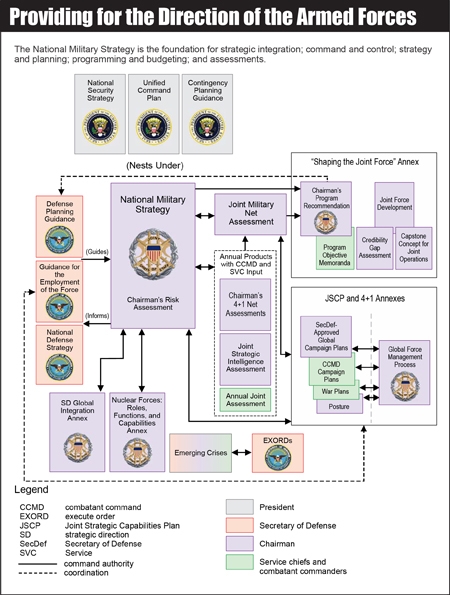The President, SecDef, and CJCS provide their orders, intent, strategy, direction, and guidance via strategic direction to the military to pursue national interests within legal and constitutional limitations. They generally communicate strategic direction to the military through written documents, but it may be communicated by any means available. Strategic direction is contained in key documents, generally referred to as strategic guidance. Strategic direction may change rapidly in response to changing situations, whereas strategic guidance documents are typically updated cyclically and may not reflect the most current strategic direction.
The Joint Strategic Planning System (JSPS) is the primary system by which the CJCS carries out USC-assigned statutory responsibilities. The JSPS enables the CJCS to conduct assessments; provide military advice to the President, SecDef, NSC, and Homeland Security Council (HSC); and assist the President and SecDef in providing strategic direction to the US Armed Forces. The NMS and JSCP are core strategic guidance documents that provide CJCS direction and policy essential to the achievement of NSS objectives by augmenting the strategic direction provided in the UCP, GEF, and other Presidential directives. Other elements of JSPS, such as the CJCS risk assessment, the joint strategy review, and the annual joint assessment (AJA), inform decision making and identify new contingencies that may warrant planning and the commitment of resources.

The President, SecDef, and CJCS use strategic direction to communicate their broad goals and issue-specific guidance to DOD. It provides the common thread that integrates and synchronizes the planning activities and operations of the JS, CCMDs, Services, joint forces, combat support agencies (CSAs), and other DOD agencies. It provides purpose and focus to the planning for employment of military force. Strategic direction identifies a desired military objective or end state; national-level planning assumptions; and national-level constraints, limitations, and restrictions. In addition to previously mentioned documents, additional strategic direction will emerge as orders or as part of the iterative plans dialogue.
A. National Military Strategy (NMS)
The NMS, derived from the NSS and DSR, prioritizes and focuses the efforts of the Armed Forces of the United States while conveying the CJCS’s direction with regard to the OE and the necessary military actions to protect national security interests. The NMS defines the national military objectives (ends), how to accomplish these objectives (ways), and addresses the military capabilities required to execute the strategy (means). The NMS provides focus for military activities by defining a set of interrelated military objectives and joint operating concepts from which the Service Chiefs and CCDRs identify desired capabilities and against which the CJCS assesses risk.
B. Joint Strategic Capabilities Plan (JSCP)
The JSCP is the primary document in which the CJCS carries out his statutory responsibility for providing unified strategic direction to the Armed Forces. The JSCP provides military strategic and operational guidance to CCDRs, Service Chiefs, CSAs, and applicable DOD agencies for preparation of plans based on current military capabilities. It implements the planning guidance provided in the GEF and the joint planning activities and products that accomplish that guidance. In addition to communicating to the CCMDs’ specific planning guidance necessary for planning, the JSCP operationalizes the strategic vision described in the NMS and nests with the strategic direction delineated by the NSS, DSR, and the DOD’s planning and resourcing guidance provided in the GEF. The JSCP also provides integrated planning guidance and direction for planners
C. Global Force Management Implementation Guidance (GFMIG)
The GFMIG documents force planning and execution guidance and show assignment of forces in support of the UCP. GFM aligns force assignment, apportionment, and allocation methodologies in support of the DSR and GEF, joint force availability requirements, and joint force assessments. It provides comprehensive insights into the global availability of US military resources and provides senior decision makers a process to quickly and accurately assess the impact and risk of proposed changes in force assignment, apportionment, and allocation. JS prepares the document for SecDef approval, with the Joint Staff J-8 [Director for Force Structure, Resource, and Assessment] overseeing the assignment and apportionment of forces and the Joint Staff J-3 [Operations Directorate] overseeing the allocation of forces.
 This article is an extract from "JFODS6: The Joint Forces Operations & Doctrine SMARTbook, 6th Ed. (Guide to Joint Warfighting, Operations & Planning)" by The Lightning Press. Download a free PDF sample and learn more at: JFODS6: The Joint Forces Operations & Doctrine SMARTbook, 6th Ed. (Guide to Joint Warfighting, Operations & Planning).
This article is an extract from "JFODS6: The Joint Forces Operations & Doctrine SMARTbook, 6th Ed. (Guide to Joint Warfighting, Operations & Planning)" by The Lightning Press. Download a free PDF sample and learn more at: JFODS6: The Joint Forces Operations & Doctrine SMARTbook, 6th Ed. (Guide to Joint Warfighting, Operations & Planning).
Browse additional military doctrine articles in our SMARTnews Blog & Resource Center.
About The Lightning Press SMARTbooks. Recognized as a “whole of government” doctrinal reference standard by military, national security and government professionals around the world, SMARTbooks comprise a comprehensive professional library. SMARTbooks can be used as quick reference guides during operations, as study guides at education and professional development courses, and as lesson plans and checklists in support of training. Browse our collection of Military Reference SMARTbooks to learn more.













































